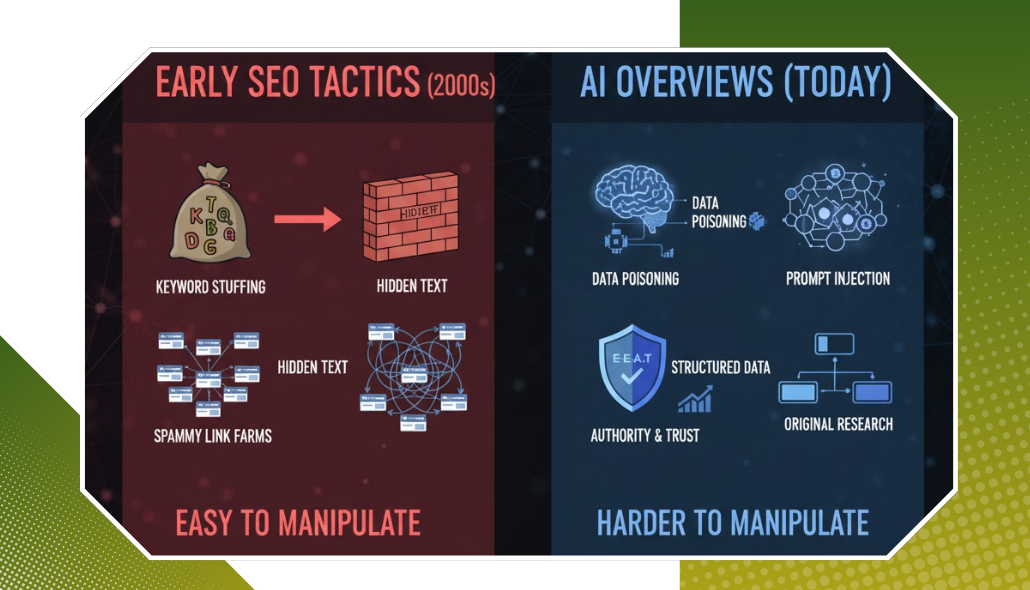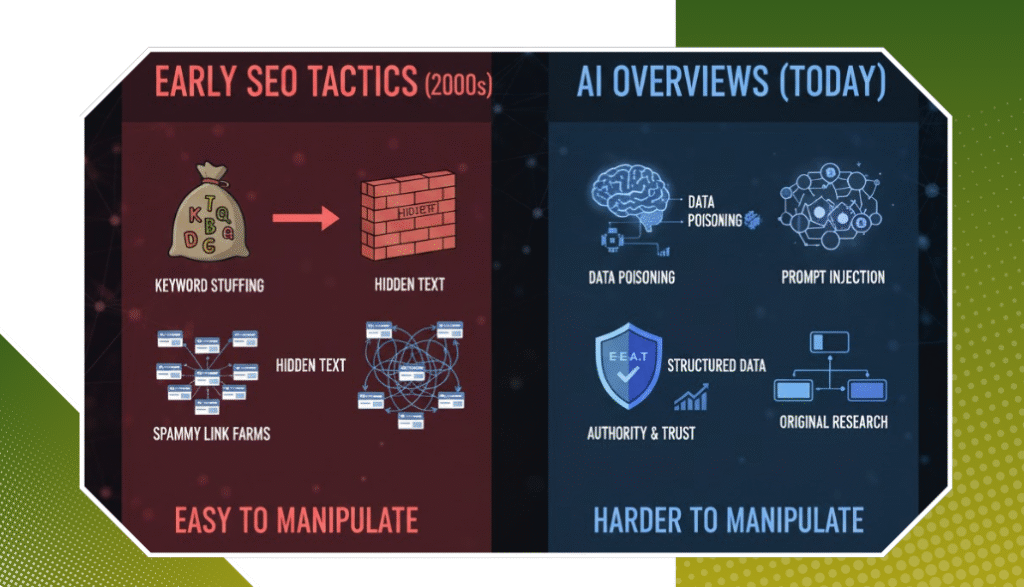For anyone who helps websites get found on Google (we call that SEO, or “Search Engine Optimisation”), a big question comes up: Can we “trick” or “manipulate” these new AI Overviews, just like people used to try to trick Google in the early days of the internet?
In this blog, we’ll dive into this question. We’ll compare it to some old tricks people used to play with search engines. And, most importantly, we’ll see why trying to trick AI might not be such a smart idea for modern SEO pros.
What Are AI Overviews and How Are They Made?
When you ask Google a question, these LLMs read tons of information from many websites. They look for patterns in the content and use those to create a quick, easy-to-read summary directly on the search page. They also rely on lots of “data signals” – things that tell Google if a piece of content is good, trustworthy, and relevant.
The good things about them: They give you quick answers, saving you time. The current limits: Sometimes, because they’re so new, they can make mistakes or give incomplete answers. Google is always working to make them better and more accurate.
The “Wild West” Days of Early SEO
In the early 2000s, when Google was still relatively new. Back then, some people attempted to “trick” Google to get their websites to rank higher. These were referred to as “manipulative SEO tactics.”
Here are some common tricks they used:
- Keyword Stuffing: This was like repeating the same words over and over and over again on a page, even if it sounded silly. For example, “We sell shoes, buy shoes, best shoes, discount shoes, shoes online.” They thought more keywords meant a higher ranking. It made the content unreadable for humans.
- Hidden Text and Links: People would put keywords or links on their page in the same colour as the background, so you couldn’t see them. But Google’s old systems would “see” them, and the website might rank higher.
- Link Swapping (or Link Farms): Websites would agree to link to each other, even if their content wasn’t related. It was like saying, “I’ll pretend you’re important if you pretend I’m important,” just to trick Google into thinking they had lots of “votes” (links).
- Low-Quality, Mass-Produced Content: People would churn out tons of very similar, badly written articles, sometimes even using computer programs to “spin” (rewrite) existing articles, hoping quantity would beat quality.
Can We Still “Trick” AI Overviews Like Old SEO?
This is the big question: Can people use similar tricks to make their content show up in AI Overviews? The answer is: Some people are trying, and sometimes it works, but it’s risky.
Some SEO agencies are indeed trying to mimic old tactics to influence AI Overviews:
- Creating Many Self-Referencing Pages: They might create many articles all linking to each other on their own site, hoping to trick AI into thinking they are a huge “expert” on a topic. It’s like building a little echo chamber on their own website.
- Minimal Human Oversight: Some use AI tools to create tons of content very quickly, with very little human checking or editing. They just hope the AI will pick up something from the sheer volume.
- “Best Of” Lists: One current trick being observed is creating articles that claim a person or company is the “best” in a certain group, even if the article is on that person’s or company’s own website. Then, AI Overviews might pick up on this “best” claim and cite it. For example, “Top 5 SEO Experts (and I’m #1!)” was written by the #1 expert’s own company website.
The Dangers of Trying to “Trick” AI Overviews
Just as with past SEO tactics, which tried to play the system, going after AI Overviews is a high-risk play which brings with it serious issues:
- Lower Quality Answers: If AI reports begin to include info from biased sources, the quality of the answers will go down. They may become less useful, less accurate at what they report, or may present false information. Google’s AI has already had some embarrassing errors where it gave bad advice (like recommending eating glue or rocks) because it pulled from unreliable sources.
- Loss of Trust: If people start seeing bad or untrustworthy answers from AI Overviews, they will stop trusting them. This hurts Google, but it also hurts the websites that get featured, even if they didn’t mean to be manipulative.
- Misinformation and Bias: Manipulative content can spread wrong information or push biased viewpoints. This is a big concern for everyone relying on AI summaries for quick facts.
- Google Will Catch On: Just as Google eventually figured out keyword stuffing and link farms, its AI systems are constantly learning. Google has powerful “SpamBrain” systems that use AI to fight spam. They are already going after sites which are using low-quality AI-generated content to manipulate rankings.
The Smart Way Forward: Real Expertise and Trust
Instead of outsmarting AI, we may instead do better and more safely to present what is real and foster human trust. This means:
- Real Expertise and Experience: Google’s AI (and real people!) want to see that your content comes from someone with real Experience, Expertise, Authority, and Trustworthiness (E-E-A-T).
- Experience: Have you actually done what you’re writing about? Share your personal stories and insights.
- Expertise: Do you truly know a lot about this topic? Show your deep knowledge.
- Authority: Are you seen as a leader or trusted source in your field by others?
- Trustworthiness: Is your content accurate, honest, and is your website secure?
This is what Google’s AI is really looking for. It wants to give people reliable answers.
- Genuine Engagement: Create content that people genuinely want to read, share, and interact with. This builds real relationships.
- Thought Leadership: Aim to be a go-to source for new ideas, fresh perspectives, and deep insights in your industry. When you’re a true thought leader, people (and AI) naturally look to you for answers.
- Quality Content Creation: Focus on making your content the best it can be. Make it clear, helpful, well-researched, and easy to understand. Google’s stance is clear: they will go for quality content which is people-first, no matter the format. They punish content which is put out just for search engine tricks.
What’s Next: Smarter AI and Tougher Penalties
The world of AI search is still changing very fast. Here’s what we can expect in the future:
- AI Will Get Even Smarter at Spotting Tricks: Just like Google’s regular search engine learned to spot old SEO tricks, its AI systems will get much better at finding and ignoring manipulative attempts. They’ll learn to tell the difference between real expertise and sneaky signals.
- Better Understanding of “Real” Content: Future AI will likely get better at understanding genuine human experience and original research, making it harder for automatically generated, low-quality content to win.
- Stricter Rules: Google will continue to adjust its rules and procedures to maintain the quality of search results and fight against spam, no matter what new forms it takes.
Conclusion
In today’s age of AI-driven search, what we are seeing is a great shift toward authenticity and quality. Which brands and which websites that put out real value, which display true expertise and which have useful content are the ones which will do well in the long term. It is an issue of balance between the adoption of the new tech and responsible use to make search a better experience for all.
Don’t risk your website’s future with old-school tricks that AI is learning to beat. Focus on sustainable SEO practices that build real trust. If you need expert guidance to make your content truly shine and ethically get noticed in the new world of AI search, contact us at Rankingeek Marketing Agency for SEO services. We can help you build a strategy that works, for good!




